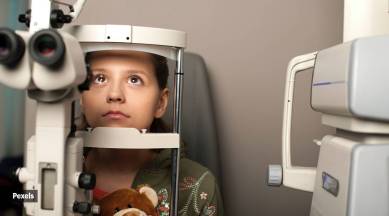Ocular TB is a clinical disease, has various modes of transmission and can affect any part of the eye. Normally, symptoms involve vision problems and headaches but these may not show up in a rare one per cent of affected cases like our patient, says Dr Samrat Shah, Internal Medicine Expert, Apollo Spectra, Pune
Abida*, a 21-year-old student pursuing a medical laboratory technician course from Yemen, was clueless as to why she had lost more than 14 kg in a span of three months. It was only after a chance visit at a Pune hospital to meet her aunt, who was recovering after a bariatric surgery, that Abida found out the reason for her massive weight loss was due to a rare form of tuberculosis in her eyes!
You have exhausted your
monthly limit of free stories.
To continue reading,
simply register or sign in
Continue reading with an Indian Express Premium membership starting Rs 91 per month.
This premium article is free for now.
Register to continue reading this story.
This content is exclusive for our subscribers.
Subscribe to get unlimited access to The Indian Express exclusive and premium stories.
This content is exclusive for our subscribers.
Subscribe now to get unlimited access to The Indian Express exclusive and premium stories.
Dr Samrat Shah, Internal Medicine Expert, Apollo Spectra, Pune said initially, he too was baffled as several rounds of tests had ruled out autoimmune and other genetic diseases. “Abida visited her aunt in hospital sometime in August-September. She had also complained of weight loss, fever, extreme fatigue and underwent a series of medical tests. Detailed questioning about her clinical history eventually showed that she used to have a blurring of vision while in college,” Dr Shah recalls.
An eye examination also showed the presence of multiple granulomas and her unexplained weight loss was then attributed to a rare form of TB in her eyes. The initial TB skin test was negative but when Abida told the doctor it was done improperly, the team conducted a second test, which showed TB positivity.
Ocular TB is a clinical disease, has various modes of transmission and can affect any part of the eye. Clinical manifestations of ocular TB vary, posing a challenge for diagnosis. In general, blurred vision and light sensitivity are the most common symptoms and may be the only reported symptoms. Patients can also be asymptomatic or have other complaints, such as headaches, flashes, floaters or redness of the eye. Ocular TB without symptoms is seen in just one per cent of the affected cases, Dr Shah points out.
Abida was horrified at the diagnosis. “My world came crashing down when I came to know about TB in my eyes. I was shocked to hear this. I was aware that TB affects the lungs but didn’t know about the eyes. I was scared and didn’t know how to react. What if TB robs my vision? Will I be able to see properly? These were some of the questions that bothered me. But, the skilled team of doctors cleared all my doubts and helped in my recovery. I am fine now and have resumed my normal routine,” she says. Once she started medication and counselled about possible side effects, she went back to Yemen. Now she does regular follow-up via telemedicine consultation and coordinates with local doctors. “As she was diagnosed early, the TB was restricted to her eyes and she did not land up with disseminated TB. On her last visit to India, she had gained eight kg of weight and did not have a fever. Her follow-up visit is due in April,” Dr Shah adds.
(*The name has been changed for purposes of anonymity)











